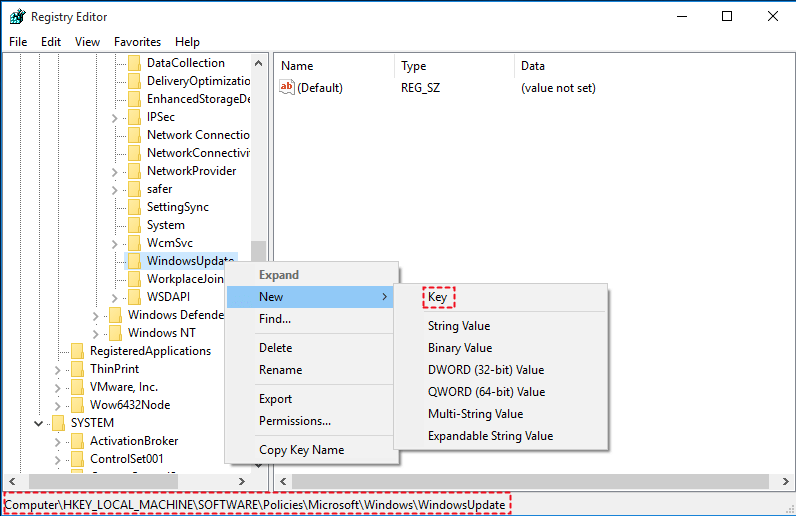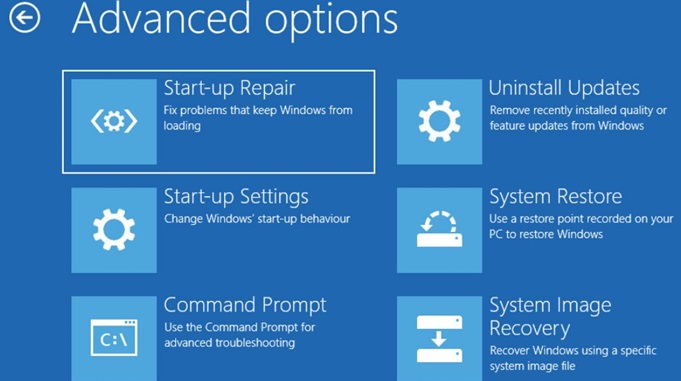

- #FAILED WINDOWS 10 UPDATE REGISTRY KEYS TO REMOVE HOW TO#
- #FAILED WINDOWS 10 UPDATE REGISTRY KEYS TO REMOVE INSTALL#
- #FAILED WINDOWS 10 UPDATE REGISTRY KEYS TO REMOVE FULL#
Create a new registry GPP entry in the section User Configuration > Preferences > Windows Settings > Registry. You can also use GP Preferences to remove a specific key or registry entry on computers in a domain.įor example, you want to delete a certain parameter in the registry key HKEY_CURRENT_USER. #FAILED WINDOWS 10 UPDATE REGISTRY KEYS TO REMOVE HOW TO#
How to Delete Registry Key Using the Group Policy Preferences?
#FAILED WINDOWS 10 UPDATE REGISTRY KEYS TO REMOVE INSTALL#
To add it to the OS, you have to install the KB943729 update (client-side extensions for Group Policy). In Windows XP and Windows Server 2003, the GPP section is absent. The final report with policy settings in the GPMC console looks like this:
Item-level targeting - can be used to target registry settings via GPP based on computer settings, and/or user properties at a granular level.  Apply once and do not reapply - apply the policy for each computer only once. Remove this item when it is no longer applied - if you unlink GPO from the AD container, the changed registry settings will return to their initial state. If the user doesn’t have local admin permissions, the policy will be applied only to the HKEY_CURRENT_USER hive. If you check this option, the parameter will be created with the current user permissions. Run in logged-on user’s security context - the registry parameter is created in the context of the current user. There are many useful options on the Common tab: Delete - removes a registry key and all of its values and subkeys. Replace - if the registry item already exists, deletes and recreates registry item (rarely used). If not, a parameter with the specified value will be created Update (default) - if the parameter already exists, its value will be updated with the specified in the GPP. If the parameter already exists, the value does not change Create - creates a registry parameter. There are 4 types of operation with the registry items: As a default, set the policy option to the Update mode. HKEY_USERS - affects individual user profiles. HKEY_CURRENT_CONFIG (HKEY_LOCAL_MACHINE\System\CurrentControlSet\Hardware Profiles\Current), HKEY_LOCAL_MACHINE, HKEY_CURRENT_USER (HKEY_USERS\.Default will be used if you’ll set HKCU registry key using Computer Configuration Policy) HKEY_CLASSES_ROOT (HKEY_LOCAL_MACHINE\Software\Classes),
Apply once and do not reapply - apply the policy for each computer only once. Remove this item when it is no longer applied - if you unlink GPO from the AD container, the changed registry settings will return to their initial state. If the user doesn’t have local admin permissions, the policy will be applied only to the HKEY_CURRENT_USER hive. If you check this option, the parameter will be created with the current user permissions. Run in logged-on user’s security context - the registry parameter is created in the context of the current user. There are many useful options on the Common tab: Delete - removes a registry key and all of its values and subkeys. Replace - if the registry item already exists, deletes and recreates registry item (rarely used). If not, a parameter with the specified value will be created Update (default) - if the parameter already exists, its value will be updated with the specified in the GPP. If the parameter already exists, the value does not change Create - creates a registry parameter. There are 4 types of operation with the registry items: As a default, set the policy option to the Update mode. HKEY_USERS - affects individual user profiles. HKEY_CURRENT_CONFIG (HKEY_LOCAL_MACHINE\System\CurrentControlSet\Hardware Profiles\Current), HKEY_LOCAL_MACHINE, HKEY_CURRENT_USER (HKEY_USERS\.Default will be used if you’ll set HKCU registry key using Computer Configuration Policy) HKEY_CLASSES_ROOT (HKEY_LOCAL_MACHINE\Software\Classes),  In the following fields (Hive, Key path, Value type, Value data) you have to specify the registry hive (HKLM, HKCU, etc.) registry key parameter name, type, and value.
In the following fields (Hive, Key path, Value type, Value data) you have to specify the registry hive (HKLM, HKCU, etc.) registry key parameter name, type, and value. #FAILED WINDOWS 10 UPDATE REGISTRY KEYS TO REMOVE FULL#
You can also type the full registry key path and a parameter name manually: The next time Group Policy is updated on computers (or after running the gpupdate command), the specified registry settings will be applied on all computers in the OU.
This completes the registry policy setting. 
To set a specific registry parameter value, use the Update option (look below) You can change its value and the desired action.
This parameter with the full reg path and value will be imported into the GPO editor console. In this example, we want to add only one registry item to our GPP - REG_DWORD parameter named SearchOrderConfig. Use the Registry Browser tree to locate and select an existing registry key/parameter Specify the remote computer name (or an IP address) to connect. You can connect to the registry on the remote computer, and select the existing registry key and parameter Registry Wizard allows you to browse the registry on a local computer. Select in the context menu: New > Registry Wizard Expand the following GPO section: Computer (or User) Configuration > Preferences > Windows Settings > Registry. After that, switch it to the GPO Edit mode Create a new (or edit an existing) GPO, and link it to the appropriate Active Directory Organizational Unit. Open the Group Policy Management Console ( gpmc.msc). Lets’ try to use the GPO Registry Wizard to set the registry parameter value: Registry Item - allows you to manually change a single registry key, parameter name, and value. Useful if you need to add a group of registry keys Collection Item - creates and organizes registry items in a folder. Registry Wizard - allows you to use a local remote computer as a reference with the built-in GPP registry browser. There are three options for selecting the registry key on the target PCs: Note that depending on the registry hive (HKEY_LOCAL_MACHINE / HKEY_CURRENT_USER), you must apply the settings through the Computer or User configuration GPP, respectively. The registry settings are available in the Computer and User configurations GPO section.







 0 kommentar(er)
0 kommentar(er)
